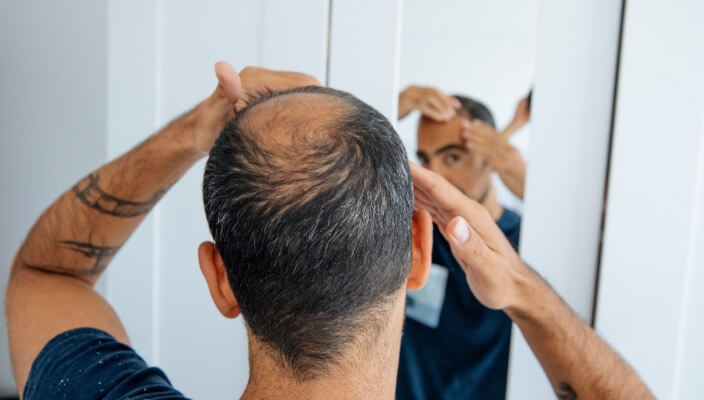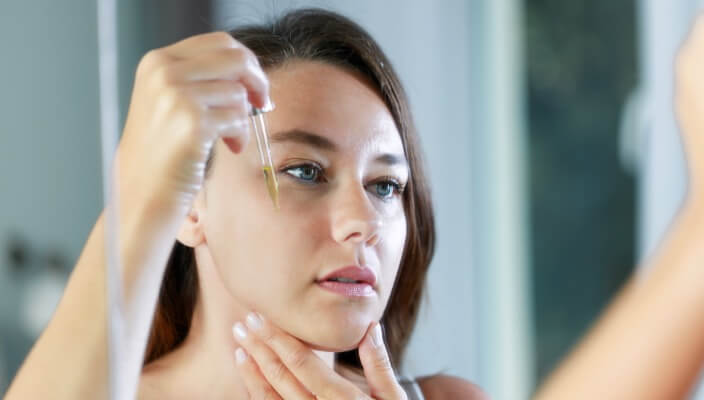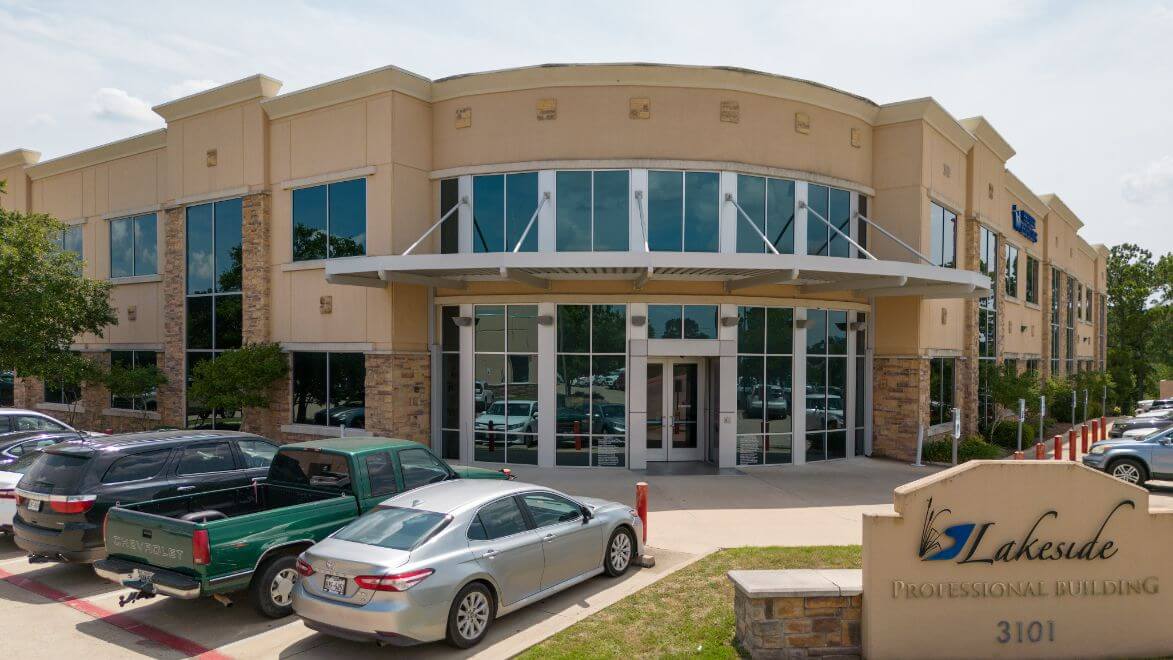Hair Loss: Causes & Treatment Options
How Can I Treat and Prevent Hair Loss?
 Hereditary hair loss is incredibly popular among men and women. It can affect body hair as well as hair just on your scalp. Also known as alopecia, hair loss is more prevalent in older adults, although it can occur in children as well. This condition happens when the hair someone loses normally throughout the day does not get replaced. Most people notice more hair in the drain after washing their hair or larger clumps of hair in their brush. Others note thinning patches or balding patches on their head in the mirror. If you have noticed that you are losing hair faster than usual, you may benefit from hair loss treatment. Tru-Skin Dermatology provides a wide range of information about hair loss, causes, and treatment options for all people. Contact us today to schedule your appointment for hair loss treatment in Central Texas.
Hereditary hair loss is incredibly popular among men and women. It can affect body hair as well as hair just on your scalp. Also known as alopecia, hair loss is more prevalent in older adults, although it can occur in children as well. This condition happens when the hair someone loses normally throughout the day does not get replaced. Most people notice more hair in the drain after washing their hair or larger clumps of hair in their brush. Others note thinning patches or balding patches on their head in the mirror. If you have noticed that you are losing hair faster than usual, you may benefit from hair loss treatment. Tru-Skin Dermatology provides a wide range of information about hair loss, causes, and treatment options for all people. Contact us today to schedule your appointment for hair loss treatment in Central Texas.
What Causes Hair Loss?
There are many different causes for hair loss, depending on the person. One of the first steps we’ll conduct during your initial appointment is identifying the cause of your hair loss. The most common cause is hereditary male- or female-pattern baldness. If your family has a history of hair loss, you may exhibit it as well. Other causes include hormones triggering hair loss. Some of the other causes of hair loss include:
- Pregnancy
- Childbirth
- Menopause
- Changing birth control options
- Thyroid disease
- Major illnesses
- Surgeries
- Traumatic events
- Autoimmune response like alopecia areata
- Scalp infections
- Medications used to treat cancer, high blood pressure, arthritis, depression, and heart problems
- Physical or emotional shock
How Do You Diagnose Hair Loss?
Identifying hair loss can depend on many different factors. We will determine the cause based on a physical exam and discussing your health and family history. Sometimes, the case is mild, and a quick dietary or small lifestyle change can help treat your hair loss. We may suggest changing your prescription medications. More serious cases, such as autoimmune or skin diseases, may require a biopsy of your skin for a better look. Hair growth is a complicated process that takes time and fine-tuning to find the cause and a successful treatment plan.
Hair Loss Treatment Options
There are many different treatment options for hair loss. They include medication and medical procedures. We’ll go over all options with you after diagnosing the cause of your hair loss.
Medication
We will most likely turn to medication as the first course of treatment for your hair loss. Over-the-counter medications, such as topical creams and gels, also known as Rogaine, contain the main ingredient minoxidil. We may prescribe a higher strength medication along with other treatments. Prescription medications can also include oral medication to slow daily hair loss. Some side effects of oral medications for hair loss include a diminished sex drive or impaired sexual function. Prednisone is another popular medication for treating alopecia areata. It helps reduce the inflammation and suppresses the immune system from making the discomfort worse. Corticosteroid can also reduce inflammation. Taking medication for hair loss needs to be closely monitored by yourself as well as our team to watch for possible side effects. Some side effects can include:
- Glaucoma
- Fluid retention in the legs
- High blood pressure
- High blood sugar
- Infections
- Cataracts
- Calcium loss
- Thin skin
- Bruising
- Sore throat
Medical Procedures
In more severe cases, medication cannot treat hair loss. We will then turn to medical procedures. These surgeries are in-depth and require multiple visits for completion. There are risks as well, including:
- Patchy hair growth
- Infections
- Bleeding
- Scarring
Hair Transplant Surgery
This process involves relocating small plugs of skin and hair to bald places on your scalp. Because people typically lose hair on the top of their head rather than the rest of their body, we can carefully relocate hair to the top of the head. This is a process that requires multiple surgeries as hair loss is progressive.
Scalp Reduction
A scalp reduction surgery involves a surgeon removing part of your scalp that is void of hair. We then close this piece with a part of the scalp that does have hair. Tissue expansion covers the bald spots, requiring two surgeries.
How Can I Prevent Hair Loss?
While hair loss is most prominently hereditary, there are treatments and steps you can take to help prevent additional hair loss. These techniques include:
- Avoiding wearing your hair in tight hairstyles, such as braids, ponytails, and buns. These put too much pressure on your follicles, damaging them.
- Try not to put too much pressure on your hair in general. Avoid rubbing, pulling, and twisting it.
- Maintain a balanced diet that includes plenty of iron, protein and take multivitamins.
- Try washing your hair every other day instead of every day.
- Avoid harsh styling products that can damage your hair, including blow dryers, heated combs, straighteners, bleaching agents, relaxers, and coloring products.
- Style your hair with the lowest settings possible when using heat.

Tru-Skin Dermatology Can Help You Face The World With Confidence
If you are struggling with hair loss, schedule a consultation at Tru-Skin Dermatology. Our team will create a customized treatment plan for your hair loss and help you regain your confidence.
Featured Products

Nutrafol Hairbiotic MD 90 day
Improves hair growth by targeting root causes of hair thinning with added nutrition and gut health support from 11 pre- and probiotic strains. Available in 30 or 90-day supply.

CLn Healthy Scalp Shampoo
CLn Shampoo includes salicylic acid and sodium hypochlorite, and is designed for flakey scalps. It is an effective shampoo for normal-to-oily scalp and skin. Designed for scalp and skin prone to folliculitis, dermatitis, dandruff, beard dandruff and acne. 12 fl oz / 354 mL
Related Blogs

- General Dermatology
Your skincare routine is not just about what you apply to your skin. It’s also about what you eat.
Read More
- General Dermatology
- Skin Care
A good facial cleanser is a crucial part of any skincare regimen. But not all cleansers are created equal. Are you using a facial cleanser that is tailored to your skin’s specific needs? Read this blog to learn what to look for.
Read More
- General Dermatology
- Skin Care
In this blog post, we’ll take a closer look at the benefits of Vitamin C for skincare and explore how incorporating this ingredient into your routine can help you achieve your best skin yet.
Read More


